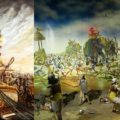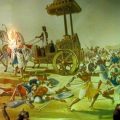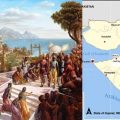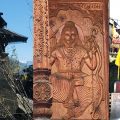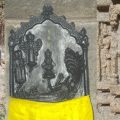2000 BCE Bhaghpat Chariot and its Impact on Archaeo-Astronomical Dating of Kurukshetra War
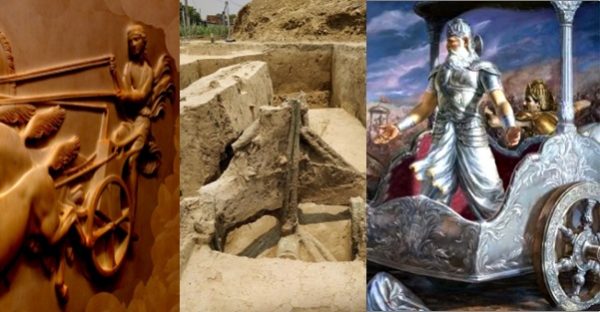
Many of you might have heard about the recent discovery of a chariot dating back to 2000 BCE to 1800 BCE at Bhagaprasta (Bhaghpat) a town only a few kilometers away from Indraprastha (Delhi) discovered by Dr SK Manjul and ASI team of archaeologists. This is a major discovery and an important milestone in providing the 100 crore plus Bharatiyas, their much denied ancient history recorded in our Veda-Itihasa-Puranas. The wheels of the Bhagpat chariot are not spooked but solid wheels as per the current understanding. There were also shields, torch, crowns, helmets, mirrors made of copper, copper antenna swords, daggers, gold beads etc.
PGW and Harappan cultures are already merging both geographically (in the Western UP & Eastern Haryana region, which is known by the ancient name of Kuru Rashtra) and chronologically (in the 600 BCE to 2000 BCE period) blurring the boundaries between Bronze Age and Iron ages in this spatio-temporal region.
A refined and solid pre-history of BharataVarsha is only a few steps away and along with it, this may subsequently settle the IE migration question as well much more conclusively, but only if we don’t try to muddy the currently arrived at clarity by bringing other dating theories falling deep into the past.
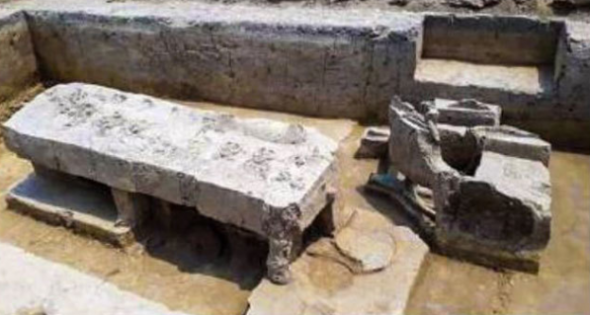
Bhagpat Chariot Excavation Site
This goes well with the 1792 BCE (14th October 1792 BCE to be precise) date of Kurukshetra War proposed by Dr Ashok Bhatnagar. For the first time we have got a material evidence through the Bhagpat chariot corroborating well with an MBH date arrived at through archaeo-astronomy!
For those who are not familiar with Dr Ashok Bhatnagar’s research work on dating of the Mahabharata, here it is- The Research paper of Dr Ashok Bhatnagar on the Dating of Mahabharata, published in the INSA IJHS.
MBH dating has now diverged into three competing dates and friends like us have backed one or the other dates. Many published books, many articles written, many films and documentaries authored, with hours and days spent on each of them. Huge effort and commitment on each of the dates. So it is not an easy task to switch between the chosen dates.
He has also provided a rebuttal to another date of Mahabharata arrived at by Dr Narhari Achar, which too is based on archaeoastronomy. Dr Achar dates the Kurukshetra War to 3067 BCE, 22nd November 3067 BCE to be precise. Dr Achar’s critique of Dr Bhatnagar’s date and his rejoinder to Dr Achar’s critique can be accessed here in this correspondence.
Archaeoastronomy is a branch of astronomy involving the analysis of ancient sky charts using a category of software tools (commonly known as the planetarium software tools) that can mathematically generate the layout of ancient sky, by accurately locating the position of the planets, sun, moon, comets and stars at ancient dates that fall into as old as 3000 BCE or 5000 BCE. The older the date, the lesser the accuracy of the computer generated sky map. Krishna Dvaipayana Vyasa, the composer of Mahabharata, has mentioned the position of the planets and other celestial bodies in the sky during the start of the peace mission of Krishna and many such events that occurred before or during the Kurukshetra War. This helps archaeo-astronomers like Dr Bhatnagar and Dr Achar to arrive at a probable date for the Kurukshetra War.
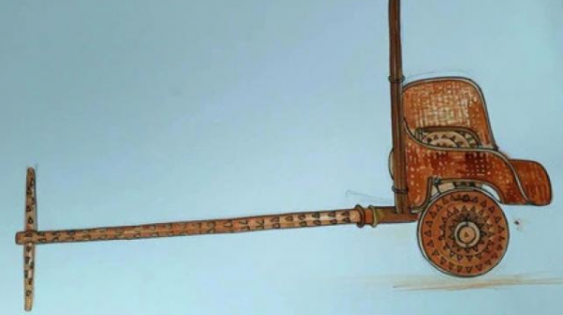
The sketch of a typical chariot, like the one excavated in Bhagpat
However, due to the cyclic nature of the planetary motion, approximate celestial body alignment that resembles the observation reported by Vyasa, repeats in course of a few millennia. This results into different Kurukshetra War dates arrived at by different researchers. There are more than two dozen of different Kurukshetra War dates arrived at by different researchers, spanning from 1200 BCE to 7200 BCE based on archaeo-astronomy, vedanga-jyotisha and other disciplines. However these dates has now broadly diverged into three competing dates:- the 1792 BCE date of Dr Ashok Bhatnagar, the 3067 BCE date of Dr Achar and the 5561 BCE (16th October 5561 BCE) date of Nilesh Oak. The 3067 BCE date is also known as the 3K date and the 5561 BCE date is known as the 5K date. Many published books, many written articles, many documentary films and many research papers are created based on each of these dates, with much fan following for each research scholar.
If the archaeological research does push the envelope even further, the date of 3067 BCE which is only some 1100 years away into the past, will sure come back to the limelight. But as of now, based on where archaeology stands today, Bhatnagar ji’s date of 1792 BCE comes to the limelight. A discovery of chariot in Kurukshetra region earlier than that date, in 1800 BCE to 2000 BCE period, means a lot to his date and gives it a rock solid foundation.
In his research paper Dr Ashok Bhatnagar makes these following comments:-
“In this study, we have simulated and analysed astronomical events recorded in 52 different ślokas taken from 10 different Parvas of MB. Accurate description of the Kārtika Pūrimā and Revatī Nakatra in autumn season in MB helped us to locate the autumnal equinox between Viśākhā and Anurādhā Nakatras, limiting the period of MB from the year 2250 BCE to 1280 BCE. Beyond these limits, Kārttika month of sidereal luni-solar Indian calendar begins to lose its connection with the short, post-monsoon autumn in northern India around Delhi-Kurukshetra region. Precise details of the winter solstice in the Amānta Māgha month, when the Moon was in the first quarter of its phase, further helps us to determine the precession of the Maghā (α Leonis) that brings us closer to the time of MB, around the year 1773 BCE. We have used description of occurrence of an eclipse pair in one lunation and then a lunar eclipse on Kārtika Pūrimā in the same year to finally close in on the year of the war as -1792 (1793 BCE). From there, all other events follow accurately as per daily account given in MB, in the same sequence as given in the epic. We determine that the Great War began on 14 October 1793 BCE (Gregorian). We have shown that very few references of astronomical events match for any other dates between 3102 BCE to 3140 BCE based on Kali era beginning in 3102 BCE. We also show mismatches of the event dates in earlier determinations. The accuracy with which such large number of events matches the computed dates cannot be by coincidence. This shows that the events were actually observed and recorded. The calendar used in MB establishes that foundations of Vedāga Jyotia were laid around this time and given a mathematical form soon thereafter.
We have the other dates of 3067 BCE determined by Achar (2003) and 1478 BCE by Iyengar (2003). Achar (2003) favours Raghavan’s earlier determination of the date of 3067 BCE by testing it for a few events in Udyoga and Bhīma Parvas. The date for Ka’s departure for peace talks does not conform to end of autumn season as clearly described in his benchmark śloka, but falls nearly 22 days earlier in the rainy season over Delhi/ Hastinapur. The date fails the fundamental requirement of placing the equinoxes in the right place. The other dates determined by them are in error by 3 to 12 days, e.g., winter solstice occurs on Māgha Śukla 5 instead of Māgha Śukla 8±1 at the time of Bhishma’s demise. The time elapsed from the beginning of war up to the time of Bhishma’s demise, from their dates, comes out as 56 days instead of 68 days quoted in so many ślokas in MB. In that respect, the date determined by Iyengar (2003) broadly falls in the correct domain dictated by the equinoxes and solstices as per the prevailing season. It is based on the eclipse pairs identified to have occurred in 1478 BCE in the year when Saturn and Mars met the description in MB. He mentions that the war began immediately after the Kārttika Pūrimā, which occurred on Julian 12th October 1478 BCE. Winter solstice follows 83 days later on Julian 3rd January 1477 BCE, which does not match the figure of 68 days up to Bhīma’s demise.”
The significance of Bhagaprasta the location where the chariot is unearthed is that the name Prasta seems to be a popular place-name-suffix in the Kuru Rashtra region during the Kurukshetra War period. We have Indraprastha which is also known as Shakraprasta and Khandavaprasta. Then there are Paniprasta (Panipat), Yamaprasta, Svarnaprasta (Sonipat), Tilaprasta (Tilpat) and so on in this same region. Bhagaprasta, the real Sanskrit name of Bhagpat, means the city of Bhaga. Here Bhaga is one among the Aditya devatas along with Indra, Aryaman, Vishnu and Vivasvat. Indraprasta is named after Indra. There were pilgrim places named after other Adityas like Aryaman, Mitra and Varuna in the same Kurukshetra region along Sarasvati river, making it the holy land of Adityas, linking it to the Rigvedic age as well.
Since the currently arrived at date of the Bhagpat Chariot is not an extraordinary claim (like for example a claim of discovery of a chariot or a city in 5000 BCE or 7000 BCE ) and the possible date variations are spanning in the 1900-1300 BCE or 1600-1500 BCE time sectors, the final declaration of the date is not going to be dramatically affecting a Mahabharata date such as 1792 BCE (or those falling in the range of 1600 BCE to 1300 BCE) as the gaps between these dates are only few centuries and not millennia.
What the Sky says (i.e. archeo-astronomy) and what the Earth says (i.e. archaeology) is in this case very close (only years, decades or centuries apart and not millennia apart like in the case of 3K and 5K dates). This is what is more important than anything, which gives the hope that a final solution is just out there near the horizon.
We cannot treat MBH dating problem in isolation.
The aim has to be in settling the chronological sequence of all the datable events starting from Rigveda to Itihasas to the Puranas or at least Rigveda and Mahabharata. When we focus on that, it is not important to try to fit every one of the 60 or 70 datable references in the Mahabharata and then arrive at a Kurukshetra War date satisfying each of them, only to end up dating it to 5K or 3K which is at odds with what we know about the absolute chronology of events in Rigveda, thanks to the works of Shrikant Talageri in his three books AIT A Reappraisal, Rigveda A historical Analysis and Rigveda and Avesta, the Final Evidence.
One compelling reason for not to attempt to date absolutely every datable events mentioned in MBH is that these narrations are made by poets. Poetic embellishment and errors in the observed astronomical data is to be anticipated. So the best approach is to reject some datable astronomical data from MBH by identifying it as either of these (poetic exaggeration or erroneous observation / narration) and then go with those data which is clear and unambiguous. After doing this, if your date agrees with the available information from archaeology and most of the other disciplines (climatology, geology, hydrology, linguistics, technology evolution such as that of the chariots), one should go with that date, rather than going with another date where every available datable references in Mahabharata is accounted for but the final date is at odds with all of these other disciplines ending up in 3K and 5K.
Thus, the problem with the 5K or 3K dates of MBH is that, these are arrived at focusing only at archaeo-astronomy with the primary focus on local optimization-only MBH dating (making sense to the maximum number of datable references in MBH, using ancient sky charts) where the larger picture of chronological sequencing of events in the the entire literature (Veda-Itihasa-Puranas) with a solution to IE migration question, archaeological discoveries, hydrological changes (drying up of Sarasvati, drainage dynamics of north India), climate changes , language evolution and so on occurring in 7K, 5K, 3K, 2K periods, not being in the back of mind of the researcher.
I can see very good coherence between Talageri’s last book (Rigveda and Avesta, the Final Evidence) and Dr Bhatnagar’s dating of Mahabharata to 1792 BCE. Both are independently developed not depending on each other. Talageri’s work is primarily based on IE linguistics, comparative Analysis of Rigveda and Avesta and available archaeological records in North India up to the realms of the Mitannis in the west, while Dr Bhatnagar’s work is based purely on archae-astronomy, independent of linguistics and archaeology. Yet both matches quite well between each other and also with archaeology.
This is where I see a significance in Bhatnagar ji’s date of Kurukshetra War.
It is to be noted that chariots and its wheels undergo evolution. In early part of Rigveda, solid wheel chariots are mentioned. In later part of the Rigveda and in Mahabharata Kurukshetra War, spoked wheel chariots are mentioned, which is an innovation over the solid wheel as it makes the chariot lighter and agile.
Considering Krishna Dvaipayana Vyasa as the compiler of the Vedic corpus, and considering his forefathers like Vasistha (Vasistha > Shakti > Parasara > Vyasa > Pandu > Arjuna < Abhimanyu):- seven generations:- translating to a span of around 200 years) were the primary contributors of RigVeda, we have the result of spoked wheel chariot development as an innovation over the solid wheel, its mention in the later parts of Rigveda and also in Mahabharata and its use in Kurukshetra War – all these matching up quite well.
It goes without saying that a spoked chariot wheel discovery in the Kuru region, younger to the currently discovered solid wheel by around 200 years, is still missing, and if found, will strengthen the date even further. But as mentioned before, spooked wheels get eroded faster than solid wheels. However the jury is still about the Bhagpat chariot wheel and there is still a possibility that it is a spoked wheel chariot, the explanation being that the spokes got eroded away giving the impression of a solid wheel impression in the soil.
But for the 3K and 5K dates, in order to get strengthened, a spooked wheel or at least a solid wheel, needs to be unearthed and dated to 3K or 5K dates.
Another important point worth noting is that there are many artifacts like seals dated or datable to 3000 BCE or older. Harappan / IVC / Sarasvati settlement records has crossed 7K mark, like the case of Bhirrana (varyingly dated to 7570-7180 BCE to 6689-6201 BCE) on the banks of Saraswati to the west of Kurukshetra. The Bhagpat chariot information goes in favor of 3K or 5K dates of Kurukshetra War.
But, here in my view, what we need to do is to test out the impact on the literature or the narrative by subtracting each artifact, item or technology, checking what impact the absence of that artifact or item or technology is going to have upon the entire narrative. For example, if we take away the seals (the identification seals issued to the citizen of Dwaraka, which are checked during entry or exit of the city, akin to today’s passports), the narrative of Mahabharata suffers not much dilution or distortion. But if we take away chariots, and in that the spooked wheel chariots, then the entire Mahabharata narrative including Kurukshetra War narration is severely impacted.
Besides, a technology invented at an older date is always available at a younger date (except in very rare cases where regression of technology occurs). Thus the identification-seal technology invented in 3K or older is also available at 1792 BCE. The house-construction and town-construction expertise invented in 7K is also available in 1792 BCE (in this case, but with considerable change in the style and sophistication of the construction techniques, and amazingly some regression in certain aspects of town-planning).
Then we are left with only the following options:-
For an MBH date placed at 3K or 5K:- We need to accept a chariot-less Mahabharata-narrative where warriors moved around and engaged in battles in other types of carts (bullock-carts for example), a narrative which, after many centuries, got embellished or re-composed, when spooked wheel chariots driven by horses were invented or that technology got imported into the Kuru region from elsewhere.
For an MBH date placed at younger dates like 1792 BCE or younger around 1500 BCE:- Poets are narrating the events after the spooked wheel chariots driven by horses became common in the Kuru region. Poets are able to see through direct perception, the battles fought in those chariots and proclaim “iti-haasa” (“it happened thus”)! Poets are witnessed to see the usage of identity seals. Complex town planning and construction techniques also are there for the direct observation of the poet.
Of course, aligning with the spirit of scientific discoveries this entire negative attitude towards 3K or 5K dates changes, the moment the said item or technology (like for example the spooked wheel chariots) is discovered in the said period (3K or 5K).
References:
1. The News of Bhagpat Chariot Discovery
2. Dr Ashok Bhatnagar’s Research paper dating the Mahabharata to 1792 BCE
3. The Correspondance between Dr Ashok Bhatnagar and Dr Narhari Achar
4. Shrikant Talageri’s Book: AIT A Reapprisal
5. Shrikant Talageri’s Book: Rigveda: A Historical Analysis
6. Shrikant Talageri’s Book: Rigveda and Avesta: The Final Evidence
7. Analysis of the Bhagpat Chariot Discovery by Dr S Kalyanaraman.
Featured image courtesy: Google.
Disclaimer: The views expressed here are solely of the author. My India My Glory does not assume any responsibility for the validity or information shared in this article by the author.
Jijith Nadumuri Ravi
Latest posts by Jijith Nadumuri Ravi (see all)
- 387 ‘Moplah Martyrs’ to be Removed from Freedom Struggle Dictionary - October 23, 2024
- Afghanistan Was Part of Rgvedic Horizon: A Historical Analysis - October 23, 2024
- Why Build a Statue for Rastra Purusha Krishna, the Founder of Delhi? - October 23, 2024

